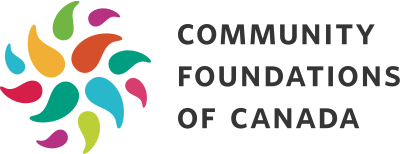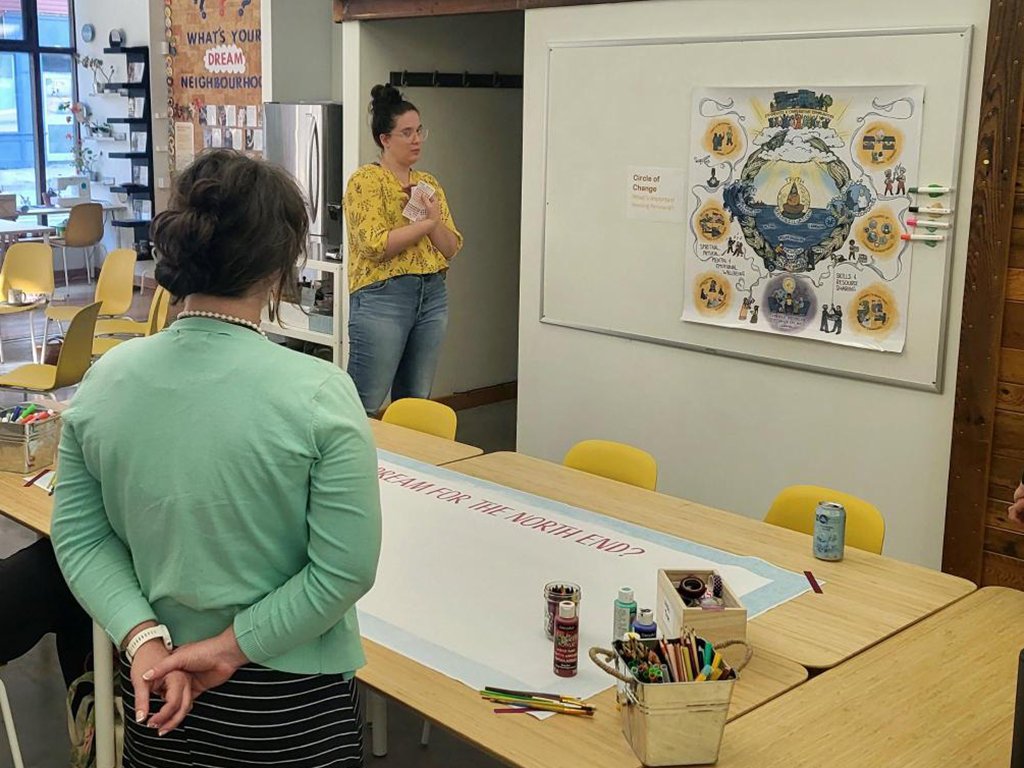This is the second part of a story series about Every One Every Day Kjipuktuk/Halifax as a practical example of inclusive social infrastructure that’s rooted in Truth & Reconciliation. You can read part one of the series, Weaving Cohesion Through Inclusive Social Infrastructure, to learn more about the importance of social infrastructures in city design and community building.
This series is a collaboration between Every One Every Day Kjipuktuk/Halifax, 7GenCities and Community Foundations of Canada.
Transcript:
Inda: I’m Inda Intiar, a Transformation Storytelling Fellow with Community Foundations of Canada. This is the second part of a series about Every One Every Day Kjipuktuk/Halifax. In this story, we’ll hear how the team from the Mi’kmaw Native Friendship Centre builds their commitment to Truth & Reconciliation into the Every One Every Day social infrastructure platform.
Music intro
Tammy Mudge: “You go open the door and it smells like sage every time…”
Inda: That’s Tammy Mudge, from Glooscap First Nation. She’s talking about the Mi’kmaw Native Friendship Centre in Kjipuktuk – the big harbour. You might know it by its colonial name, Halifax, Nova Scotia, Canada.
The Friendship Centre is facilitating Truth & Reconciliation in the north end neighbourhood of the city through an inclusive social infrastructure program called Every One Every Day. Tammy is the Learning and Evaluations Manager of Every One Every Day. Here she is talking about the program.
Tammy: We’re creating spaces that are bringing Indigenous and non-Indigenous people together that probably wouldn’t have had the opportunity otherwise. It really gives an opportunity for non-Indigenous folks to learn a bit further about the history of the local and urban Indigenous communities and about protocols and land acknowledgments, and any sort of thing that they weren’t sure where to ask or where to go.
Inda: Every One Every Day is doing this through a participatory approach to social infrastructure. It has a Neighbourhood Shop on Gottingen street that hosts a maker space, and sessions covering topics like Indigenous cultures, gardening, cultural cuisines, health and wellness, and others. Residents co-create these sessions with the help of the Neighbourhood Project Designers. This way, they can share their gifts, talents, cultures and stories.
Organizations and businesses in the neighbourhood often also provide the materials, expertise, equipment or specialized space for these sessions. There’s no threshold to participate, either. Everyone is invited to take part in their own time and capacity. Here’s Aimee Gasparetto, Every One Every Day’s Program Director.
Aimee Gasparetto: We’re so intentionally trying to design these spaces to include everyone, but we still understand that Indigenous knowledge and wisdom and worldview needs to rest at the centre of that. It makes so much sense that we would be trying to centre that in our design, in the way we work with partners, in the way we build the team and also the opportunities we create for residents.
Inda: There’s also the seasonal newspaper, which tells residents about the sessions, and also shares their stories. Using culturally-relevant content, the newspaper promotes the overarching narrative that the community has everything it needs.
All of these layers then create the conditions needed for residents to take part in, and collaborate on everyday activities. It helps them build shared lives, embrace diversity and inclusion, and actively participate in Truth & Reconciliation. Here’s Tammy again.
Tammy: A big thing we always get is how can I start to learn? And how can I act? So far, what the stories have been telling us that folks are sharing is that it really is sort of this open gate, this opportunity for those relationships to start because that’s sort of the first place, the learning and then understanding and then you get to the acting. I think that social infrastructure plays a huge role in that as far as getting that Reconcili-Action into the communities. It is about building skills and knowledge of course, but it’s also like just doing practical everyday activities together. It’s not always about the actual activity, it’s about the magic that happens and the connections that are made.
Inda: For Elder Debbie Eisan, an Anishinaabe woman who has provided guidance for Every One Every Day since the beginning, the initiative reminds her of the ways Indigenous communities function.
Debbie Eisan: It was about how our communities work way back when. Our uncles, our aunties, our grandpas and grandmas, they taught our children how to hunt, how to bead, how to sew. They taught them that so they could sustain themselves, so they could move on and teach others. The way I look at Every One Every Day is, this is what we’re doing. Everyone here in Kjipuktuk has their own spirit, and that spirit is what makes them unique and individual. We all have our own talents, whether you can see it right out, or whether it’s a little bit hidden and we have to coax it out. And if we were to share that with everyone and it doesn’t matter who you are, then how diverse and how wonderful this city of Kjipuktuk would be.
Inda: That’s how Every One Every Day envisions neighbourhoods and cities – happier, more resilient and socially connected, with local economies that are regenerative, focused on well-being and is inclusive of everyone. But getting there begins with respectful relationships – between people, nature, and place. This is why the commitment to Truth & Reconciliation is at the core of the initiative, and it is weaved into all of its objectives and outcomes. Here’s Aimee Gasparetto.
Aimee: The journey of Truth & Reconciliation that we’re all on, it is a systemic transformation. But systems transformation in my personal view and experience is so deeply connected to personal transformation. And to the experiences and opportunities that we have each and every day to build our own understanding, break down our personal walls, our collective walls, and really create opportunities to build shared lives.
Inda: The team at Every One Every Day knows that a verbal commitment to Truth & Reconciliation alone is not enough. So they created a framework and strategy to guide their work and keep themselves accountable. And Tammy led this work.
Tammy: If anybody ever wants to see, when we say we’re centering Truth and Reconciliation, what that actually means in action, and on the ground, we can bring it out and share. I just think that if we didn’t have it, we could lose sight of centering truth reconciliation. Because it’s just that, that happens so often.
Inda: For the framework, Tammy and team uses a circle of change, with the words Truth & Reconciliation and an image of a Mi’kmaw elder at the centre. You can also see this on halifaxiseveryone.ca.
Tammy: “It’s very place-based. So not only did a box and an arrow pathway not kind of seem to work, but also there’s some Mi’kmaq content in it.”
Inda: The circle is significant because it is symbolic of many Indigenous teachings. It’s also representative of the non-linear pathways of learning, Tammy says.
Tammy: We’re honoring the fact that gaining knowledge, that process is sacred. By understanding that the circle is like a continuous flow and understanding that when you make choices, and whatever the outcome is, still, you’re going to hold it as learning and you’re going to improve it the next time.
Inda: And then, there are key pillars that are necessary for the initiative to reach its goals. Advised by a group of elders and community members, the team set six pillars needed to realize their vision of a co-created and cooperative community that is self-sufficient.
Tammy: We need inclusive, meaningful participation, and need to always practice Netukulimk, which is a Mi’kmaq concept of taking care of yourself and community, but also making sure that you’re supplying for the community ahead, your ancestors ahead of you, and in the next seven generations. Those things are always needed to feed the circle of change.
Inda: Tammy also uses tree imagery to connect actions taken by the team to the framework and pillars. All of the actions are represented by leaves which are then attached to each of six branches that signify the pillars. For example, when they decided to stop using plastic water bottles, that action falls under the practice of Netukulimk that Tammy was talking about.
Tammy: Because it’s a tree, it’s a living document So it’s never final. Sometimes those leaves will fall to the ground, because we learn from it, right? But they’ll get absorbed back in, into Wsitqamu’k, Mother Earth, and come back out and perhaps be budded into a new idea or better-informed action item that we could do.
Inda: This north end neighbourhood also has historical and modern day significance for the African Nova Scotian community. Despite systemic racism and oppression, Black settlers in the area have for centuries built vibrant and connected communities. Every One Every Day wants to make sure that this is also recognized in its work, in addition to the diversity brought about by newcomers and other minoritized communities.
Tammy: There’s a lot of minorities in the north end, and they have all different ancestries and backgrounds and realities. So I do think that it Every One Every Day plays a role in that ally ship among groups to be able to change these systems that are very oppressive. Especially with community funding, with programs, it’s usually very short term and it’s very competing. It’s putting different groups against each other as opposed to giving everybody what they should have. All the groups have a big role to play.
Tammy: But I think there’s also a sense of, there’s a lot more similarities in the lived experience. And of course, colonization is all over the globe, and lots of places – it’s probably quicker to say where it’s not, but there’s still those things that are happening in everyday life that you can really connect on. I think that’s where transformation can happen, is when you can really see and feel and relate with other people’s experiences.
Tammy: We’re all treaty people, and we all need to be in good relations to get to this equity piece, of atonement for the past, and try to figure out how we can work towards loosening the legacy of colonialism.
Inda: The fact that the Mi’kmaw Native Friendship Centre is leading this initiative is significant, too, because it has been a community hub in the neighbourhood since the 1960s. Though partners like 7GenCities and others come from other parts of the country, Tammy says the Friendship Centre’s leadership of the initiative is especially important in a neighbourhood facing rapid gentrification.
Tammy: If we weren’t connected to the Friendship Centre…there’s absolutely no way. Because relationships are so key, and because the Friendship Centre was already so grounded in that community and trusted.
Inda: The Every One Every Day program is not a short-term project. It’s actually part of a roadmap that will scale up the participatory initiative in the next 5 to 10 years. The Friendship Centre is planning to replace its current facility with a larger one, just a few blocks away from the current neighbourhood shop. This building will be called Wije’winen, which means ‘come with us’ in Mi’kmaq. It will be a hub for First Nations, Inuit and Metis to connect to services, community and culture. And it’ll also be a space for everyone in the community to gather, learn and participate. Every One Every Day’s platform will be integrated into Wije’winen. Here’s Pam Glode Desrochers, Executive Director of the Mi’kmaw Native Friendship Centre.
Pam: I’ve been with the Friendship Centre for 30 yrs. And I can probably count how many times I’ve actually been to other shops or other storefronts here. Because we didn’t see ourselves in those. And I bet you, I can ask community members how many times you’ve been in our Friendship Centre, and I bet you they can count on a hand how many times they’ve been in the Friendship Centre. And that’s really sad. We work, live and play in I think a beautiful city, and yet, we’re still very separated, we’re all in our little boxes. And I wanted something bigger and better, not just for my own community, but the community.
Pam: I truly, truly believe that this project will shift and change not just for my own community, but it will give our community opportunities that I don’t think we can even see yet.
The building design for Wije’winen will be based on a turtle, and include traditional medicine gardens. It will be located at the foot of the Halifax Citadel, which is significant, too, says Tammy.
Tammy: What the citadel represents, at least in my eyes, is colonization of course, and so it’s kind of taking a bit of that story back, and maybe, dimming that light a little further.
Inda: Here’s Pam again.
Pam: This truly is not just one vision, this comes from many people. And that’s the beauty of it. This is real action.
Music outro.
Inda: To learn more about the importance of social infrastructures in city design and community building, read part 1 of this series: Weaving Cohesion Through Inclusive Social Infrastructure. You can find it on the Every One Every Day website under “stories” or the Community Foundations of Canada’s website under Initiatives – > “transformation storytelling fellowship.” A big thanks to the team at Every One Every Day Kjipuktuk; 7Gen Cities, and Community Foundations of Canada for their care and support with this story. Until next time!




